tire pressure AUDI A3 CABRIOLET 2016 Owners Manual
[x] Cancel search | Manufacturer: AUDI, Model Year: 2016, Model line: A3 CABRIOLET, Model: AUDI A3 CABRIOLET 2016Pages: 272, PDF Size: 67.88 MB
Page 15 of 272

<( co .... N r--N .... 0 r--> co
Overview
Some ind icator lights tu rn o n briefly as a fu nction
check whe n you swi tch the ig nition on. These sys
t ems are mar ke d wit h a ./ in the following tables.
If one of these indica to r li ghts does no t turn on,
there is a ma lfunction in t hat system.
Red indicator lights
r-------------
C en t r al indi cato r ligh t
¢ page 12,
Audi pre sense *
¢page98
USA models:
Brak e sys tem ./
¢page 15
Canada models:
Brak e sys tem ./
¢page 15
USA models:
Elect romecha nica l park ing brake
¢page 15
Canada models:
Electromechan ica l pa rk ing bra ke
¢page 15
Cooling system
¢page 16
Eng ine oil pressure
¢pag e 16
Alternator
c:::> page 17
Front safety belt
c:::>page 17
Steering ./
c:::> page 119
Steer ing lock
¢page 17
Eng ine st art system
¢ page 18
Eng ine stop wh ile dr iving
¢page 18
Transmiss ion malfunc tio n
¢ pa ge8 2
Adapt ive cr uise control* ./
c:::>pag e 92
Instruments and ind icator lights
USA models: spe ed wa rning sys
t em
¢ page 88
Canada models: speed wa rni ng
system
c:::> page 88
Yellow indicator lights
-------------
Cen tral indic ator light
¢ page 12,
Brake booster
¢ page 15
Electron ic Stab ilization Contro l
( ES C) ./
i=>pag e 18
Elec tronic Sta biliz ation Contro l
(ESC) ./
¢page 18
Electronic Stab ilization Contro l
(ESC)
USA models:
An ti-lock b raking sys tem (A BS) ./
c>page 18
Canada models:
Anti-lock b raking system (ABS) ./
¢page 18
USA models : safety systems ./
¢pa ge 17
Canada models : safety systems ./
c:::>page 17
Electromechanical parking brake
c:::> page 15
Hill
ho ld assist*
¢ page 19
Tire pressure mo nitor ing indicator
./
T ire p ressure mo nitor ing indicator
¢ page222 ..,.
13
Page 59 of 272
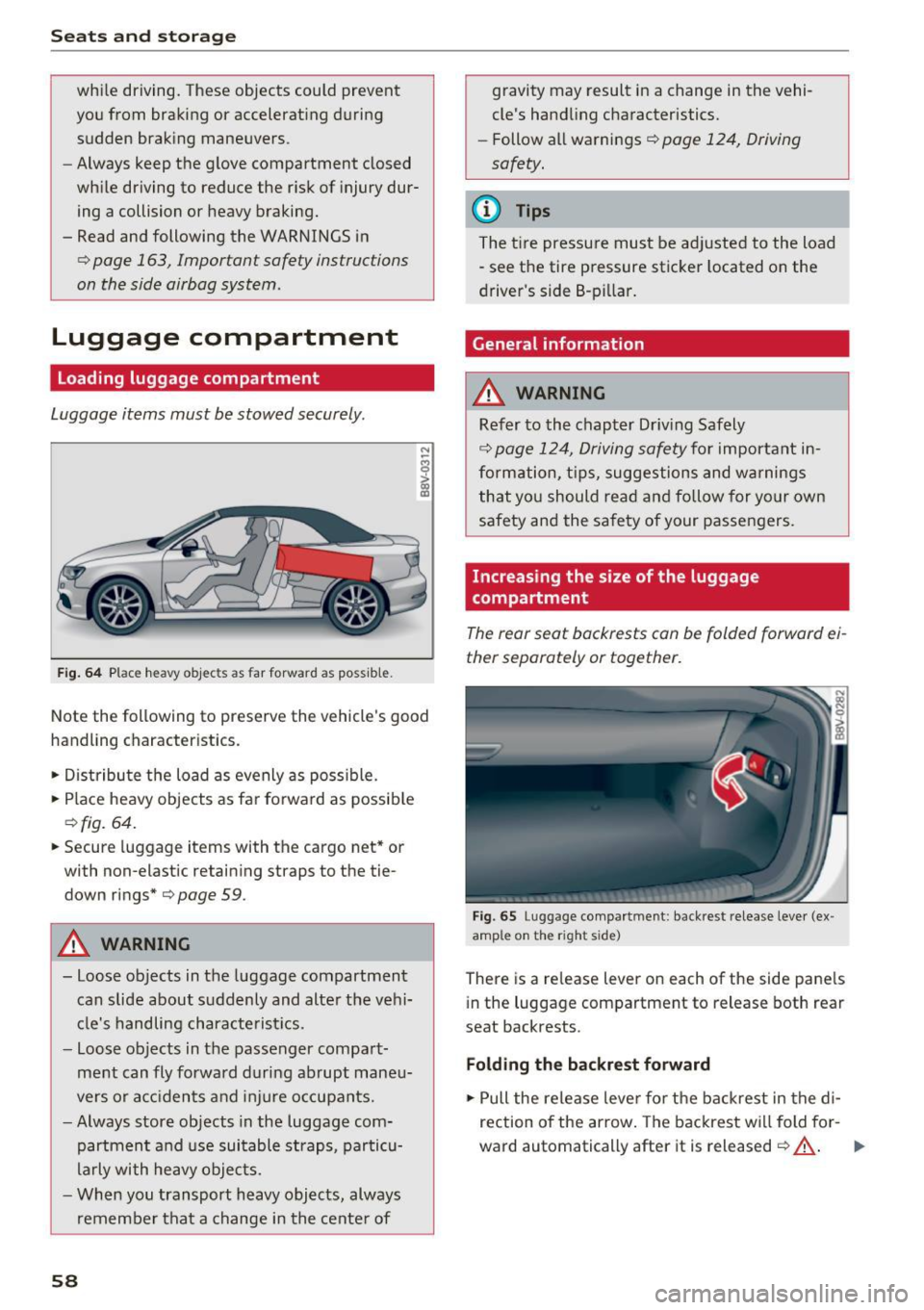
Sea ts and stor age
wh ile driving. These objects could prevent
you from braking or accelerat ing during
sudden brak.ing maneuvers.
- Always keep the g love compartment closed
wh ile driving to reduce the risk of injury dur
ing a collision or heavy braking.
- Read and following the WARNINGS in
¢ page 163, Important safety instructions
on the side airbag system.
Luggage compartment
Loading luggage compartment
Luggage items must be stowed securely.
Fig. 64 Place heavy objec ts as far forward as possible.
Note the following to preserve the vehicle's good
handling characteristics.
• Distribute the load as evenly as possible.
• Place heavy objects as fa r forward as possib le
¢ fig. 64.
• Secure luggage items with the cargo net* or
with non-elastic retain ing straps to the tie
down rings*
¢page 59.
_&. WARNING
-loose objects in the luggage compartment
can slide about suddenly and alte r the vehi
cl e's handling chara cte rist ics.
- loose objects in t he passenger compa rt
ment can fly forward during abrupt mane u
vers or a cc idents and injure occupants.
- Always store objects in the luggage com
partment and use sui table st raps, par ticu
larly with heavy objects.
- When you transport heavy objects, always
remembe r that a change in the cente r of
58
gravity may result in a change in the vehi
cle's hand ling cha racteristics.
- Follow a ll wa rnings¢
page 124, Driving
safety.
(D Tips
The t ire pressu re must be ad justed to the load
"see the tire pressure sticker located on the
driver 's side 8-p illar.
General information
_&. WARNING
Refer to the chapter Dr iv ing Safely
¢
page 124, Driving safety fo r important in
formation, t ips, suggestions and warnings
that you should read and follow for yo ur own
safety and the sa fety of your passe ngers.
Increasing the size of the luggage
compartment
The rear seat backrests can be folded forward ei
ther separately or together.
Fig. 65 Luggage compartment: backrest release lever (ex
amp le on the right s ide)
There is a re lease lever on each of the side pane ls
i n the luggage compartment to release both rear
seat backrests .
Folding the backrest forward
• Pull the release leve r for the backrest in the d i
rection of the arrow . The backrest wi ll fold fo r-
ward automatically after it is released ¢
_&. .,.
Page 86 of 272
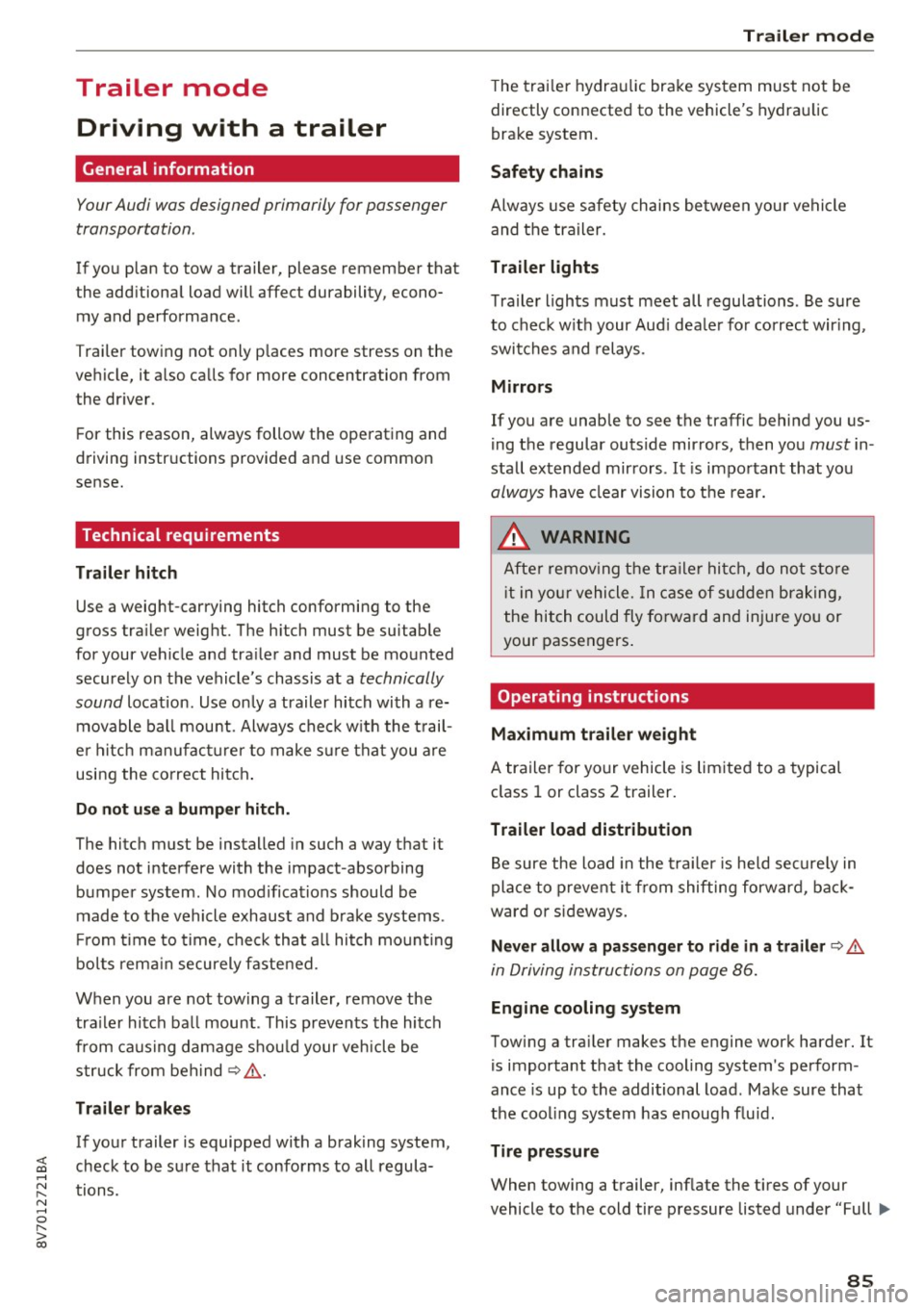
<( co .... N ,.__
N .... 0 ,.__
> co
Trailer mode Driving with a trailer
General information
Your Audi was designed primarily for passenger
transportation .
If you plan to tow a trailer, please remember that
the additiona l load will affect durability, econo
my and performance.
T railer tow ing not only p laces more stress on the
vehicle, it a lso calls for more concentration from
the dr iver.
F or this reason, always follow the operating and
driving instructions provided and use common
sense.
Technical requirements
Trailer hitch Use a weight -carrying hitch conforming to the
gross tra iler weig ht. The h itch must be suitab le
for your vehicle and tra iler and must be mo unted
securely on the vehicle's chassis at a technically
sound
location . Use on ly a trailer hitch with a re
movable ba ll mou nt. Always che ck wit h the t rail
e r hitch manufac turer to make s ure that you are
usi ng the correct hitch .
Do not u se a bumper hitch .
The hitc h must be installed in such a way t hat it
does not interfere with the impact -absorbing
bumper system . No modifications should be
made to the vehicle exhaust and brake systems .
Fr om time to time, chec k that a ll hitc h mount ing
bo lts rema in securely faste ned.
When you are not towing a trailer,
remove the
tra iler hitch ba ll mount . This prevents the hitch
from ca using damage s hou ld your veh icle be
s truck from beh ind
~ ,&. .
Trailer brakes
If your trailer is equipped with a braking system,
check to be su re that it conforms to all regula
tions .
Trailer mode
The t rai ler hydra ulic brake sys tem must not be
directly connected to the vehicle's hydra ulic
bra ke system.
Safety chains
Always use safety ch ains be tween your ve hicle
and the trailer.
Trailer lights
T ra ile r ligh ts must meet all regulations . Be sure
to chec k w it h your Aud i dea le r fo r correct wir ing,
swi tches and relays .
Mirrors
If you are unab le to see the traffic behind you us
i ng the regular outside mir rors, then you
must in
sta ll extended mirro rs . It i s important that you
always have clear vision to t he rear.
,8. WARNING
Afte r remov ing the tra ile r hi tch , do no t st o re
i t in yo ur vehicle. In ca se of sudden brak ing,
the hitch could fly fo rward and injure you or
your passengers .
Operating instructions
Maximum trailer we ight
A tra iler for your vehicle is lim ited to a typical
class 1 or class 2 trailer.
Trailer load distribution B e sure the load in the tra ile r i s held se curely in
pla ce to p reve nt i t from shifting forward, bac k
ward or si deways.
Never allow a passenger to ride in a trailer~.&.
in Driving instructions on page 86.
Engine cooling system
Towing a tra iler makes the engine work harder. It
is important that the cooling system's perform
ance is up to the additional load . Make sure that
the coo ling syst em has enoug h flu id.
Tire pressure
When towing a trailer, inflate the tires of your
vehicle to the cold tire pressure listed under
"Full ..,.
85
Page 124 of 272
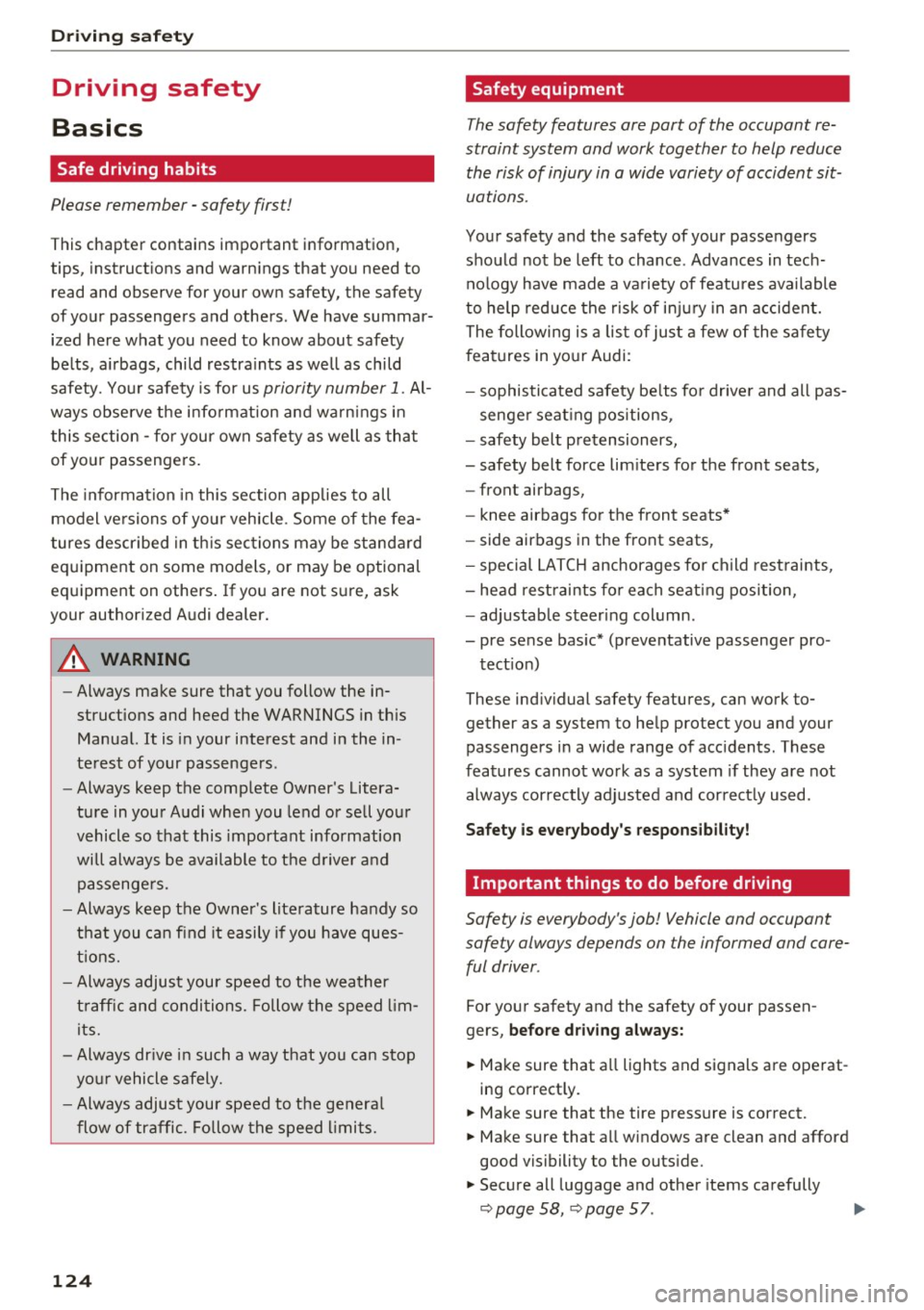
Driving sa fe ty
Driving safety
Basics
Safe driving habits
Please remember -safety first!
This chapter contains important information,
tips, instruct ions and warn ings that you need to
read and observe for your own safety, the safety
of your passengers and others. We have summar ized here what you need to know about safety
be lts, a irbags, child restra ints as well as child
safety. Your safety is for us
priority number 1 . Al
ways observe the i nfo rmation and wa rn ings in
this section - for your own safety as well as that
of your passengers.
The information i n this section applies to all
model versions of yo ur vehicle . Some of the fea
tures descr ibed in t his sections may be s tanda rd
equipment on some models, or may be optional
equipment on others . If you are not sure, ask
your authorized Audi dealer.
A WARNING
- Always make sure that you follow the in
structions and heed the WARNINGS in th is
Manual.
It is in your interest and in the in
te rest of your passengers.
- Always keep the comp lete Owner's Litera
ture in your A udi when you lend or se ll your
vehicle so that this important information
will always be available to the d river and
passenge rs.
- Always keep the Owner 's literature handy so
that you can find it easily i f you have ques
t ions.
- Always adjust your speed to the wea ther
t raff ic and conditions. Follow the speed lim
its.
- Always dr ive in such a way that you can s top
yo ur vehicle safely.
- Always adjust your speed to the genera l
flow of traffic. Follow the speed l imits.
124
· Safety equipment
The safety features are part of the occupant re
straint system and work together to help reduce the risk of injury in a wide variety of accident sit
uations.
You r safety and the safety of your passengers
should not be left to chance . Advances in tech
no logy have made a va riety of features available
to help red uce the risk of inj ury in an accident.
The following is a lis t of jus t a few of the safe ty
fea tures in yo ur Audi :
- sophisticated safety be lts fo r drive r and all pas-
senge r seat ing pos itions,
- safety belt pretensioners,
- safety bel t force lim ite rs fo r the front seats,
- front airbags,
- knee airbags for the front seats*
- side airbags in the front seats,
- special LATCH anchorages fo r child res trai nts,
- head rest raints fo r each seati ng position,
- adjustab le steering column.
- pre sense bas ic * (preventative passenger pro-
tect ion)
These ind iv idual safety features, can work to
gether as a system to he lp protect you and your
passengers i n a wide range of acc idents. These
fea tures cannot wo rk as a system if they are not
always correctly adjusted and cor rect ly used.
Safet y is e verybody's responsibility!
Important things to do before driving
Safety is everybody 's job! Vehicle and occupant
safety always depends on the informed and care
ful driver .
For your safety and the safety of your passen
gers,
be fo re dri ving always:
.. Make sure that a ll lights and signals a re operat
ing correctly.
.. Make sure that the tire pressure is correct.
.. Make sure that all windows are clean and afford
good vis ibility to the outs ide .
.. Secu re all luggage and other items carefully
,=;,page 58, ,=;,page 57 . .,.
Page 131 of 272
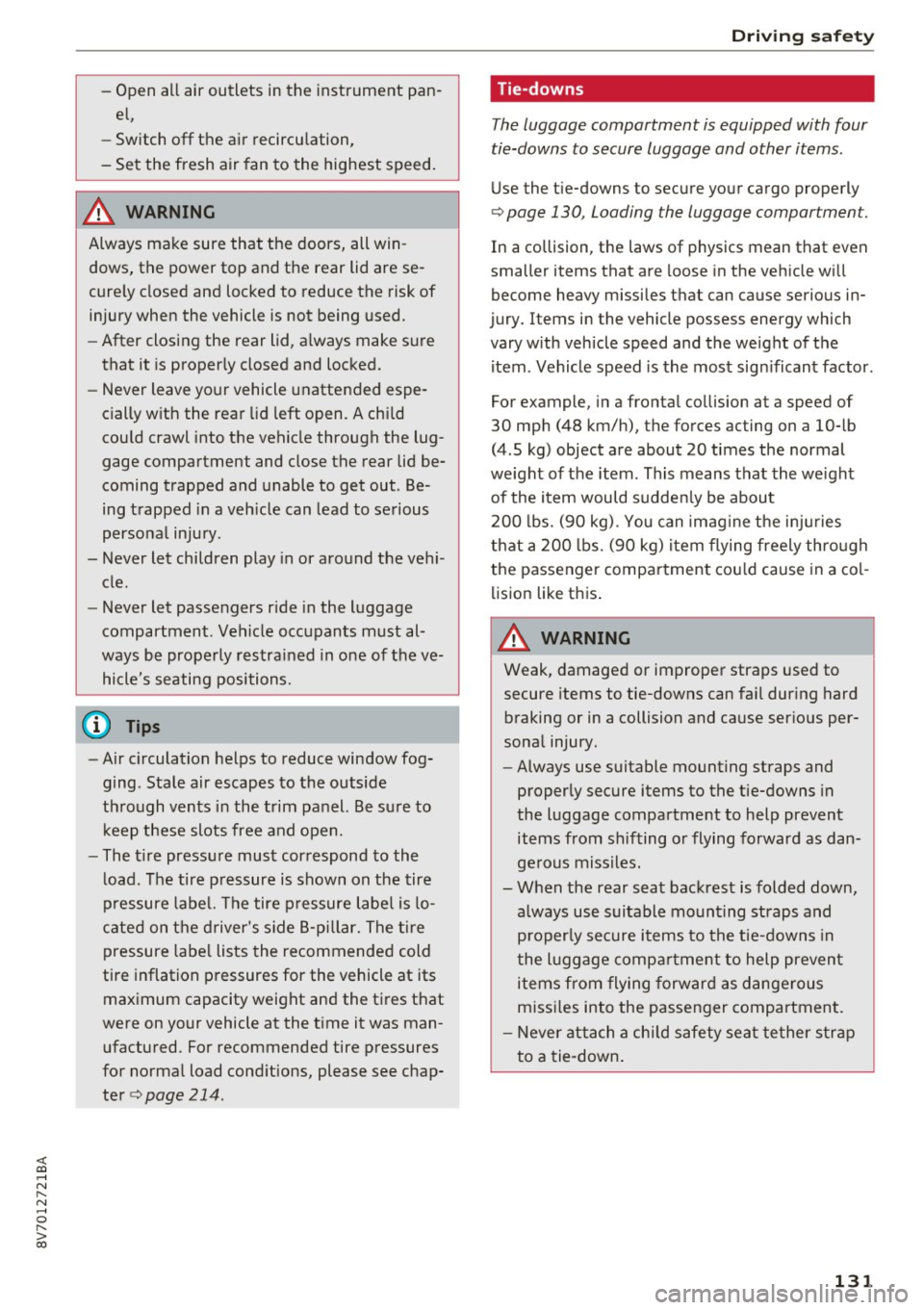
<( co .... N ,.__
N .... 0 ,.__
> co
-Open all air outlets in the instrument pan
el,
- Switch off the air recirculation,
- Set the fresh air fan to the highest speed.
& WARNING -
Always make sure that the doors, all win
dows, the power top and the rear lid are se
curely closed and locked to reduce the risk of
injury when the vehicle is not being used.
- After closing the rear lid, always make sure
that it is properly closed and locked.
- Never leave your vehicle unattended espe
cially with the rear lid left open. A child
could crawl into the vehicle through the lug
gage compartment and close the rear lid be
coming trapped and unable to get out. Be
ing trapped in a veh icle can lead to serious
personal injury.
- Never let children play in or around the vehi
cle.
- Never let passengers r ide in the luggage
compartment. Vehicle occupants must al
ways be properly restrained in one of the ve
hicle's seating positions.
(!) Tips
- Air c irculation helps to reduce window fog
ging . Stale air escapes to the outside
through vents in the trim panel. Be sure to
keep these slots free and open.
- The t ire pressure must correspond to the
l oad. The tire pressure is shown on the tire
pressure label. The tire pressure label is lo
cated on the driver's side B-pillar. The tire
pressure label lists the recommended cold
tire inflation pressures for the vehicle at its
maximum capacity weight and the tires that
were on your vehicle at the t ime it was man
ufactured. For recommended tire pressures
for normal load conditions, please see chap
ter
c> page 214.
Driving safety
Tie-downs
The luggage compartment is equipped with four
tie-downs to secure luggage and other items .
Use the tie-downs to secure your cargo properly
c> page 130, Loading the luggage compartment.
In a collision, the laws of physics mean that even
smaller items that are loose in the veh icle will
become heavy missiles th at can cause serious in
jury. Items in the vehicle possess energy which
vary w ith vehicle speed and the we ight of the
item . Vehicle speed is the most significant factor.
For example, in a frontal collision at a speed of
30 mph (48 km/h), the forces acting on a 10-lb
(4 .5 kg) object are about 20 times the normal
we ight of the item. This means that the we ight
of the item would sudden ly be about
200 lbs. (90 kg). You can imagine the injuries
that a 200 lbs. (90 kg) item flying freely through
the passenger compartment cou ld cause in a col
lision like this .
& WARNING
----
Weak, damaged or improper straps used to
secure items to tie-downs can fail during hard
braking or in a collision and cause serious per
sonal injury.
- Always use suitable mounting straps and
properly secure items to the tie-downs in
the luggage compartment to help prevent
items from shifting or flying forward as dan
gerous missiles.
- When the rear seat backrest is folded down,
always use suitable mounting straps and properly secure items to the tie-downs in
the luggage compartment to help prevent
items from flying forward as dangerous
missi les into the passenger compartment.
- Never attach a child safety seat tether strap
to a tie-down.
131
Page 206 of 272

Tires and wheels
be happy to provide more infor
mation .
® Mud and snow capability
"M/S" or "M+S" indicates the tire
is suitable for driving on mud and
snow.
& indicates a winter tire.
@ Compos ition of the tire cord
and materials
The number of plies indicates the
number of rubberized fabric lay
ers in the tire . In general: the
more layers, the more weight a
tire can carry. Tire manufacturers
must also specify the materia ls
used in the tire. These include
steel , nylon, polyester and other
materials.
@ Ma ximum permitted load
T his number indicates the maxi
mum load in kilograms and
pounds that the tire can carry.
@ Uniform tire quality grade
standards for treadwear,
traction and temperature resistance
Tread wear, t raction and temper
ature ranges
¢page 221 .
@ Running direction
The arrows indicate the running
direction of unidirectional t ires.
You must always follow the speci -
206
fied running direction
¢page 238 .
(8) Maximum permitted
inflation pressure
This number indicates the maxi
mum pressure to which a t ire can
be inflated under normal operat
ing condit ions.
Glossary of tire and loading
terminology
Accessory we ight
means the combined weigh t (in
excess of those standard items
which may be replaced) of auto matic transmission, power steer
ing, power brakes, power win
dows, power seats , radio, and
heater, to the extent that these
items are available as factory -in
stalled equipment (whether in
stalled or not).
Aspect ratio
means the rat io of the height to
the width of the tire in pe rcent.
Numbers of 55 or lower indicate a
low s idewall for imp roved steer
ing response and better overa ll
handling on dry pavement.
Page 207 of 272
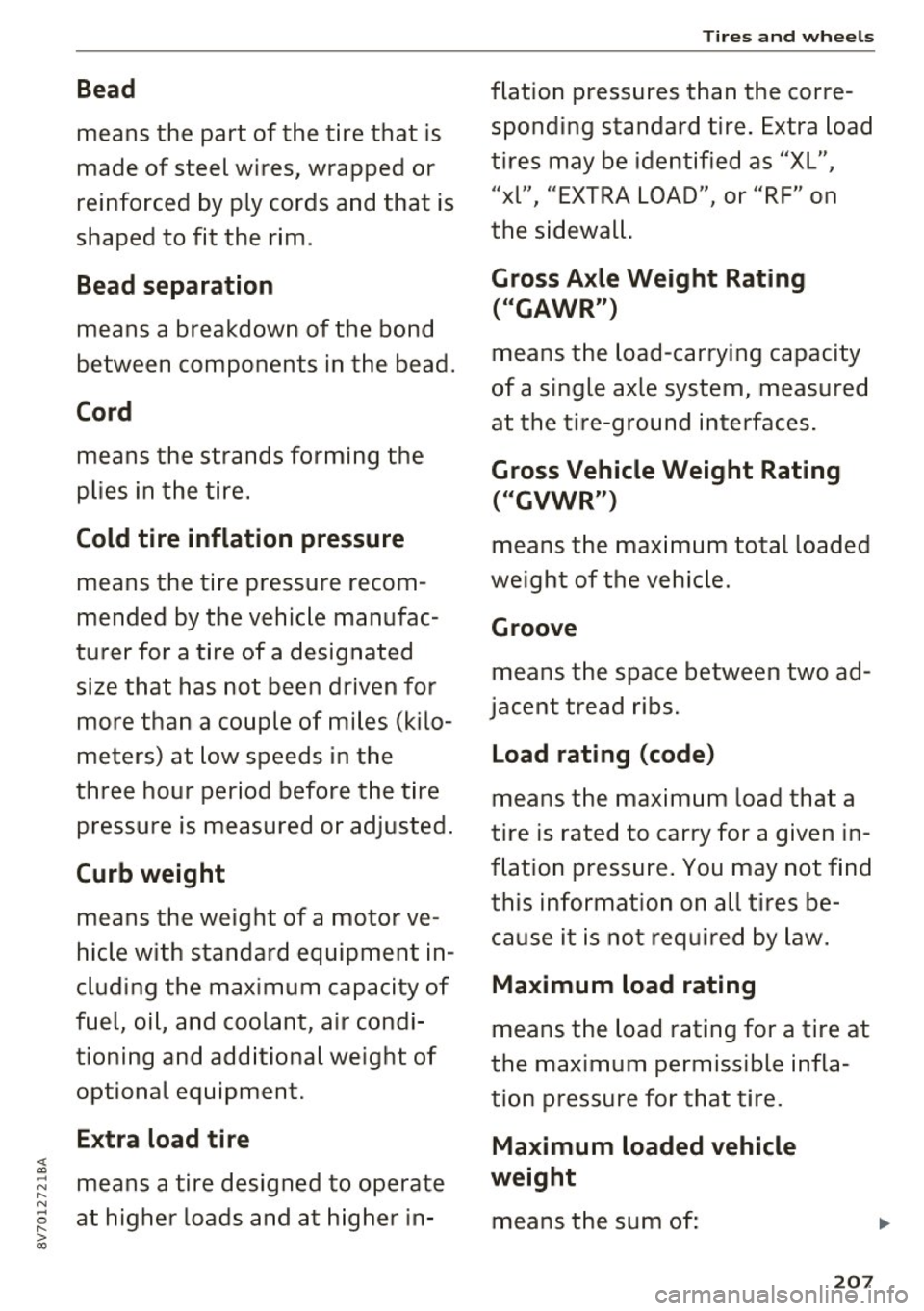
Bead
means the part of the tire that is
made of steel wires, wrapped or
reinforced by ply cords and that is
shaped to fit the rim.
Bead separation
means a breakdown of the bond
between components in the bead.
Cord
means the strands forming the
plies in the tire.
Cold tire inflation pressure
means the tire pressure recom
mended by the vehicle manufac
turer for a tire of a designated size that has not been driven for
more than a couple of miles (kilo
meters) at low speeds in the
three hour period before the tire pressure is measured or adjusted .
Curb weight
means the weight of a motor ve
hicle with standard equipment in
c luding the maximum capacity of
fuel, oi l, and coolant, air condi
tioning and add itional weight of
optional equipment.
E xtra load ti re
<( a:,
~ means a tire designed to operate
N
~ at higher loads and at higher in
s: a:,
Tires and wheels
flation pressures than the corre
sponding standard tire . Extra load
tires may be identified as "XL",
" xl", "EXTRA LOAD", or "RF" on
the sidewall.
Gross Axle Weight Rating ( " GAWR")
means the load -carrying capacity
of a single axle system, measured
at the tire-ground interfaces .
Gross Vehicle Weight Rating
("GVWR ")
means the max imum total loaded
weight of the vehicle.
Groove
means the space between two ad
jacent tread ribs .
Load rating (code)
means the maximum load tha t a
tire is rated to carry for a given in
flat ion pressure . You may not find
this informat ion on all tires be
cause it is not requ ired by law.
Maximum load rating
means the load rating for a tire at
the maximum permissible infla
tion pressure for that tire.
Maximum loaded vehicle
weight
means the sum of:
2 0 7
..
Page 208 of 272

Tires and wheels
(a) Curb weight
(b) Accessory weight
(c) Vehicle capacity weight, and
(d) Production options weight
Ma ximum (permissible )
inflation pressur e
means the maximum cold infla
tion pressure to which a tire may be inflated. Also called "maxi
mum inflation pressure ."
Normal occupant weight
means 150 lbs . (68 kilograms)
times the number of occupants
seated in the vehicle up to the to
ta l seating capacity of your vehi
c le .
Occupant d istribution
means distribution of occupants
in a vehic le .
Outer diameter
means the overall diameter of an
inflated new tire.
Overall width
means the l inear distance be
tween the exteriors of the side
walls of an inflated tire , including
elevations due to labeling , deco
rations, or protective bands or
ribs .
208
Ply
means a layer of rubber -coated
parallel cords.
Production options weight
means the comb ined weight of
those installed regular production
options weighing over 5 lbs . (2 .3
kg) in excess of those standard
items which they replace, not pre
vio usly considered in c urb weight
or accessory weight, inc luding
heavy duty brakes, ride levelers,
roof rack, heavy duty ba ttery, and
special trim.
Radial ply tire
means a pneumatic tire in which
the ply cords that extend to the beads are laid at subs tantially 90
degrees to the centerline of the
tread .
Recommended inflation
pressure
see~ page 207, Cold tire infla
tion pressure.
Reinforced tire
means a tire designe d to operate
at higher loads and at higher in
flat ion pressures than the corre
spond ing standard tire . Rein
forced tires may be identified as .,.
Page 209 of 272

<( a:, ... N .... N ... 0
s: a:,
"XL" "xl" "EXTRA LOAD" or "RF" ' ' '
on the sidewall.
Rim
means a metal support for a tire
or a tire and tube assembly upon
which the tire beads are seated .
Rim diameter
means nominal diameter of the
bead seat. If you change your
wheel size, you will have to pur
chase new tires to match the new
rim diameter .
Rim size designat ion
means rim diameter and width.
Rim width
means nominal distance between
rim flanges.
Sidewall
means that portion of a tire be
tween the tread and bead.
Speed rating (letter code )
means the speed at wh ich a t ire is
designed to be driven for extend
ed periods of time . The ratings
range from 93 mph (150 km/h)
to 186 mph (298 km/h)
¢ table
on page 205.
You may not find
this information on all tires be
cause it is not required by law .
Tires and wheels
The speed rating letter code,
where applicable, is molded on
the tire sidewall and indicates the maximum permissible road
speeds
¢ & in Winter tires on
page 219 .
Tire pressure monitoring
system*
means a system that detects
when one or more of a vehicle's
tires are underinflated and illum i
nates a low tire pressure warning
telltale .
Tread
means that portion of a tire that
comes into contact with the road.
Tread separation
means pulling away of the tread
from the tire carcass .
Treadwear indicators (TWI)
means the projections within the
principal grooves designed to give
a visual indication of t he degrees
of wear of the tread . See
¢ page 213, Treadwear indicator
for more information on measur-
ing tire wear. .,.
209
Page 212 of 272
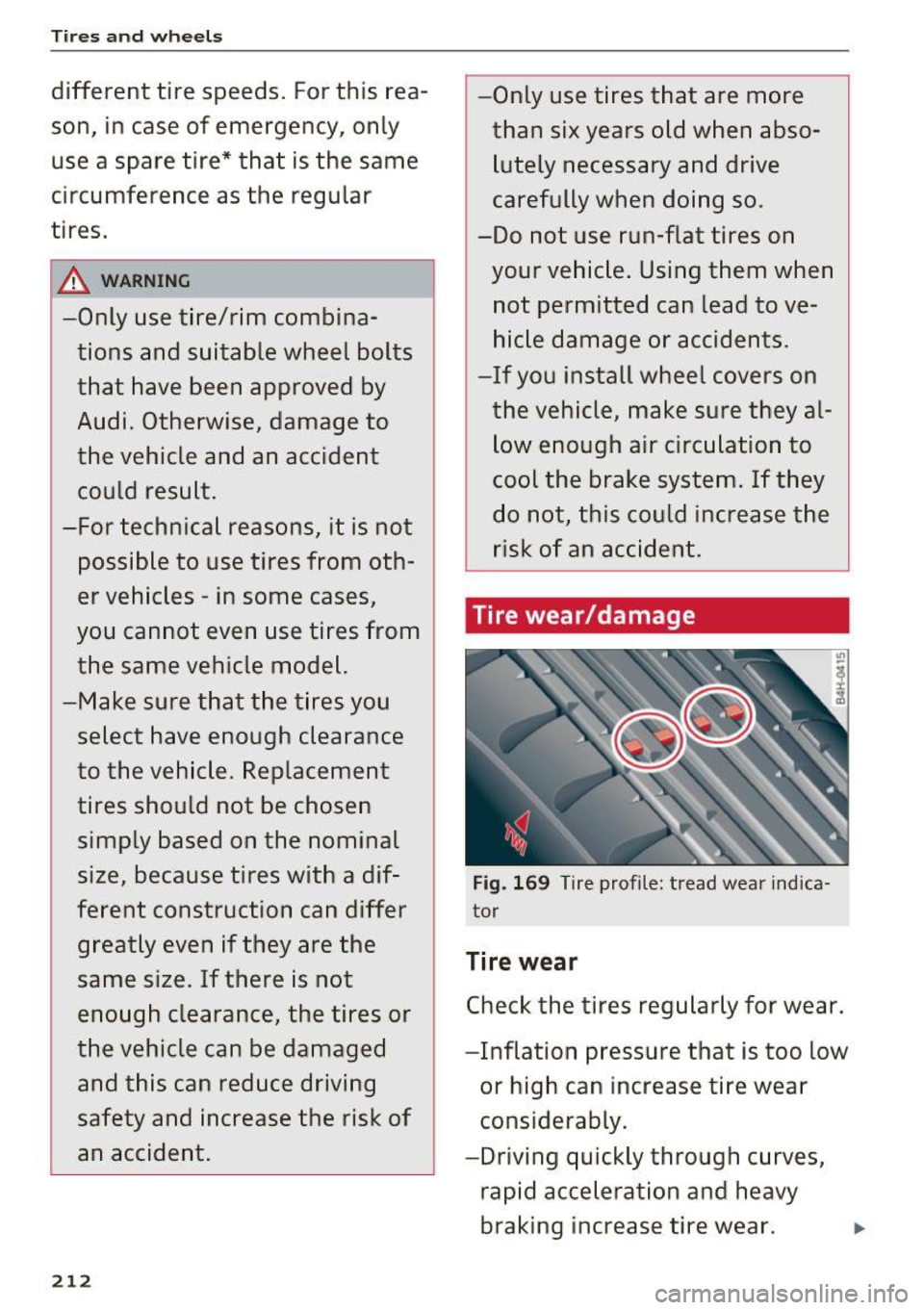
Tires and wheels
different tire speeds. For this rea
son, in case of emergency, only
use a spare tire* that is the same
circumference as the regular
tires.
,&. WARNING -
-Only use tire/rim combina
tions and suitable wheel bolts
that have been approved by
Audi. Otherwise, damage to
the vehicle and an accident could result.
-For technical reasons, it is not possible to use tires from oth
er vehicles - in some cases,
you cannot even use tires from
the same vehicle model.
-Make sure that the tires you select have enough clearance
to the vehicle. Replacement
tires should not be chosen simply based on the nominal
size, because tires with a dif
ferent construction can differ
greatly
even if they are the
same size. If there is not
enough clearance, the tires or
the vehicle can be damaged and this can reduce driving
safety and increase the risk of an accident.
212
-Only use tires that are more
than six years old when abso lutely necessary and drive
carefully when doing so.
-Do not use run-flat tires on your vehicle. Using them when not permitted can Lead to ve
hicle damage or accidents.
-If you install wheel covers on
the vehicle, make sure they al
low enough air circulation to
cool the brake system. If they
do not, this could increase the
risk of an accident.
Tire wear/damage
Fig. 169 Tire profile: tread wear indica
tor
Tire wear
Check the tires regularly for wear.
-Inflation pressure that is too low
or high can increase tire wear
considerably.
-Driving quickly through curves, rapid acceleration and heavy
braking increase tire wear. ..